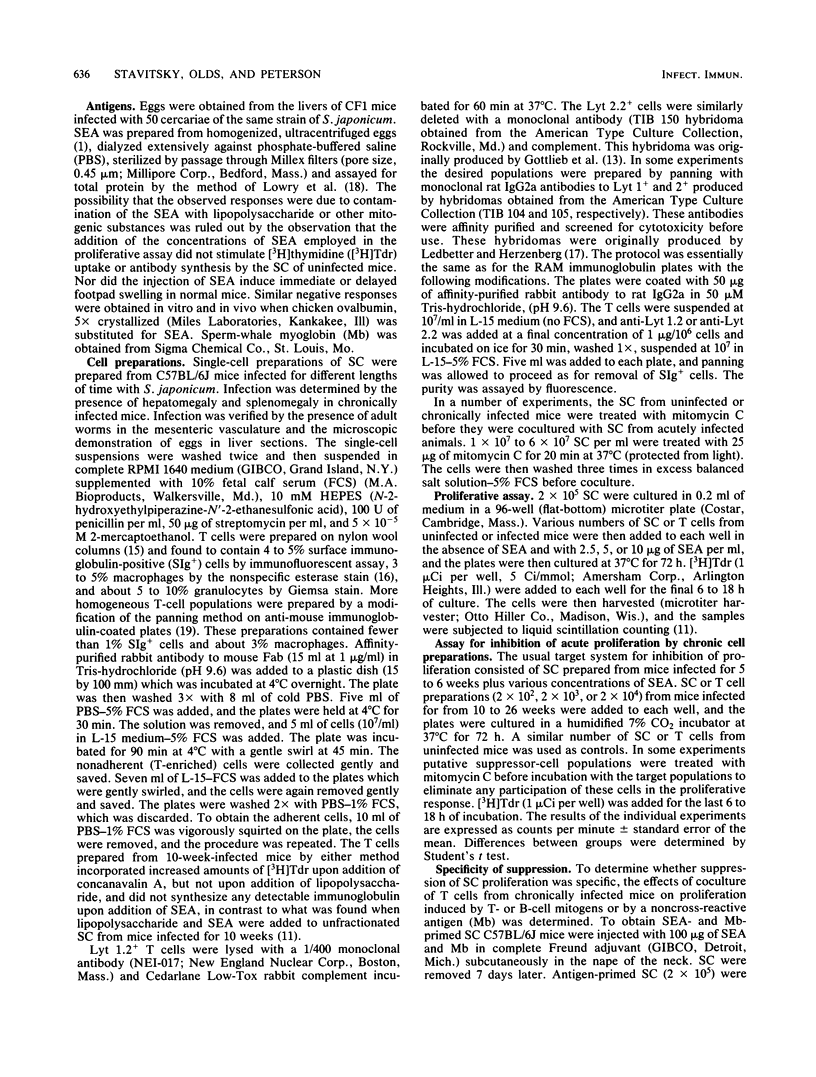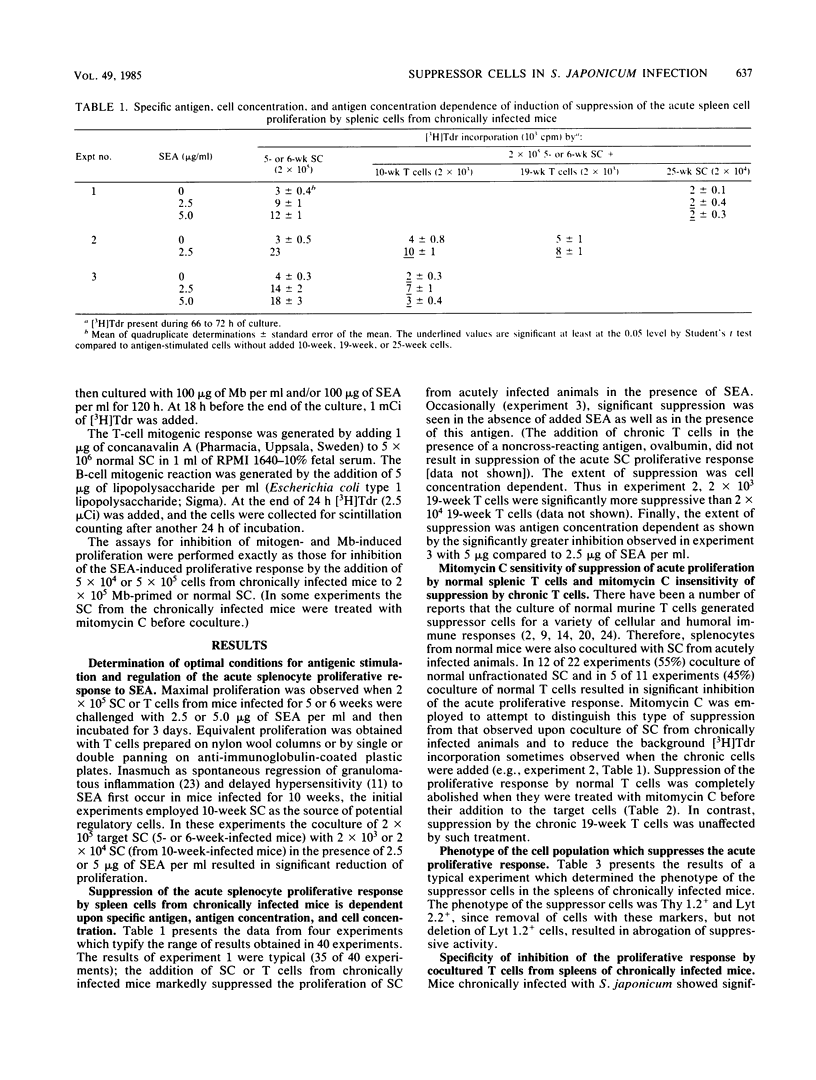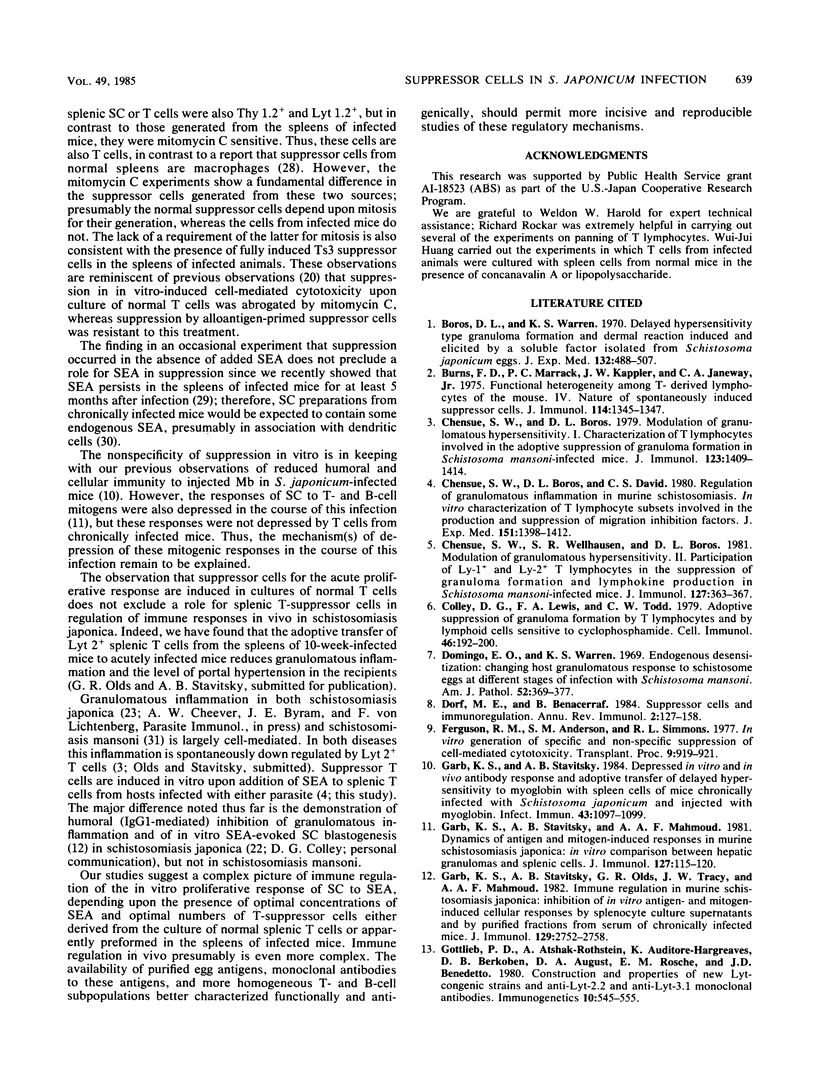Abstract
Beginning about 5 weeks after infection, C57BL/6J mice infected with Schistosoma japonicum developed granulomas around parasite eggs trapped in the liver. These granulomas attained peak size about 9 weeks after infection and then spontaneously regressed. This regression was also induced by the injection of serum immunoglobulin G1 but not lymphoid cells from chronically infected mice, but it was conceivable that lymphoid cells from mice infected for 10 weeks could also induce regression. We investigated the possibility of cellular suppression of egg antigen-induced immune responses by coculturing spleen cells from 5- to 6-week-infected mice with spleen cells from mice infected for 10 weeks or longer. Mitomycin C-resistant Thy 1.2+, Lyt 2.2+ splenic T cells from mice infected for 10 to 25 weeks consistently suppressed the egg antigen-stimulated proliferation of spleen cells from 5- to 6-week-infected mice. Suppression was dependent upon specific antigen and optimal concentrations of egg antigen and T suppressor cells. Once induced, the suppressor cells were nonspecific. Cultured T cells from uninfected mice also occasionally suppressed the acute spleen cell proliferative response, but these cells were mitomycin C sensitive. These in vitro observations suggest that granulomatous inflammation in vivo may also be down regulated by suppressor T cells and that these cells may also be implicated in the nonspecific depression of cellular and humoral responses to antigens observed during the course of this infection.
Full text
PDF





Selected References
These references are in PubMed. This may not be the complete list of references from this article.
- Boros D. L., Warren K. S. Delayed hypersensitivity-type granuloma formation and dermal reaction induced and elicited by a soluble factor isolated from Schistosoma mansoni eggs. J Exp Med. 1970 Sep 1;132(3):488–507. doi: 10.1084/jem.132.3.488. [DOI] [PMC free article] [PubMed] [Google Scholar]
- Burns F. D., Marrack P. C., Kappler J. W., Janeway C. A., Jr Functional heterogeneity among the T-derived lymphocytes of the mouse. IV. Nature of spontaneously induced suppressor cells. J Immunol. 1975 Apr;114(4):1345–1347. [PubMed] [Google Scholar]
- Chensue S. W., Boros D. L., David C. S. Regulation of granulomatous inflammation in murine schistosomiasis. In vitro characterization of T lymphocyte subsets involved in the production and suppression of migration inhibition factor. J Exp Med. 1980 Jun 1;151(6):1398–1412. doi: 10.1084/jem.151.6.1398. [DOI] [PMC free article] [PubMed] [Google Scholar]
- Chensue S. W., Boros D. L. Modulation of granulomatous hypersensitivity. I. Characterization of T lymphocytes involved in the adoptive suppression of granuloma formation in Schistosoma mansoni-infected mice. J Immunol. 1979 Sep;123(3):1409–1414. [PubMed] [Google Scholar]
- Chensue S. W., Wellhausen S. R., Boros D. L. Modulation of granulomatous hypersensitivity. II. Participation of Ly 1+ and Ly 2+ T lymphocytes in the suppression of granuloma formation and lymphokine production in Schistosoma mansoni-infected mice. J Immunol. 1981 Jul;127(1):363–367. [PubMed] [Google Scholar]
- Colley D. G., Lewis F. A., Todd C. W. Adoptive suppression of granuloma formation by T lymphocytes and by lymphoid cells sensitive to cyclophosphamide. Cell Immunol. 1979 Aug;46(1):192–200. doi: 10.1016/0008-8749(79)90258-2. [DOI] [PubMed] [Google Scholar]
- Domingo E. O., Warren K. S. Endogenous desensitization: changing host granulomatou response to schistosome eggs at different stages of infection with schistosoma mansoni. Am J Pathol. 1968 Feb;52(2):369–379. [PMC free article] [PubMed] [Google Scholar]
- Dorf M. E., Benacerraf B. Suppressor cells and immunoregulation. Annu Rev Immunol. 1984;2:127–157. doi: 10.1146/annurev.iy.02.040184.001015. [DOI] [PubMed] [Google Scholar]
- Ferguson R. M., Anderson S. M., Simmons R. L. In vitro generation of specific and nonspecific suppression of cell-mediated cytotoxicity. Transplant Proc. 1977 Mar;9(1):919–921. [PubMed] [Google Scholar]
- Garb K. S., Stavitsky A. B. Depressed in vitro and in vivo antibody response and adoptive transfer of delayed hypersensitivity to myoglobin with spleen cells of mice chronically infected with Schistosoma japonicum and injected with myoglobin. Infect Immun. 1984 Mar;43(3):1097–1099. doi: 10.1128/iai.43.3.1097-1099.1984. [DOI] [PMC free article] [PubMed] [Google Scholar]
- Garb K. S., Stavitsky A. B., Mahmoud A. A. Dynamics of antigen and mitogen-induced responses in murine schistosomiasis japonica: in vitro comparison between hepatic granulomas and splenic cells. J Immunol. 1981 Jul;127(1):115–120. [PubMed] [Google Scholar]
- Garb K. S., Stavitsky A. B., Olds G. R., Tracy J. W., Mahmoud A. A. Immune regulation in murine schistosomiasis japonica: inhibition of in vitro antigen- and mitogen-induced cellular responses by splenocyte culture supernatants and by purified fractions from serum of chronically infected mice. J Immunol. 1982 Dec;129(6):2752–2758. [PubMed] [Google Scholar]
- Janeway C. A., Jr, Sharrow S. O., Simpson E. T-cell populations with different functions. Nature. 1975 Feb 13;253(5492):544–546. doi: 10.1038/253544a0. [DOI] [PubMed] [Google Scholar]
- Julius M. H., Simpson E., Herzenberg L. A. A rapid method for the isolation of functional thymus-derived murine lymphocytes. Eur J Immunol. 1973 Oct;3(10):645–649. doi: 10.1002/eji.1830031011. [DOI] [PubMed] [Google Scholar]
- LOWRY O. H., ROSEBROUGH N. J., FARR A. L., RANDALL R. J. Protein measurement with the Folin phenol reagent. J Biol Chem. 1951 Nov;193(1):265–275. [PubMed] [Google Scholar]
- Ledbetter J. A., Herzenberg L. A. Xenogeneic monoclonal antibodies to mouse lymphoid differentiation antigens. Immunol Rev. 1979;47:63–90. doi: 10.1111/j.1600-065x.1979.tb00289.x. [DOI] [PubMed] [Google Scholar]
- Mage M. G., McHugh L. L., Rothstein T. L. Mouse lymphocytes with and without surface immunoglobulin: preparative scale separation in polystyrene tissue culture dishes coated with specifically purified anti-immunoglobulin. J Immunol Methods. 1977;15(1):47–56. doi: 10.1016/0022-1759(77)90016-3. [DOI] [PubMed] [Google Scholar]
- Nadler L. M., Hodes R. J. Regulatory mechanisms in cell-mediated immune responses. II. Comparison of culture-induced and alloantigen-induced suppressor cells in MLR and CML. J Immunol. 1977 May;118(5):1886–1895. [PubMed] [Google Scholar]
- Ohta N., Minai M., Sasazuki T. Antigen-specific suppressor T lymphocytes (Leu-2a+3a-) in human schistosomiasis japonica. J Immunol. 1983 Nov;131(5):2524–2528. [PubMed] [Google Scholar]
- Olds G. R., Mahmoud A. A. Kinetics and mechanisms of pulmonary granuloma formation around Schistosoma japonicum eggs injected into mice. Cell Immunol. 1981 May 15;60(2):251–260. doi: 10.1016/0008-8749(81)90267-7. [DOI] [PubMed] [Google Scholar]
- Olds G. R., Olveda R., Tracy J. W., Mahmoud A. A. Adoptive transfer of modulation of granuloma formation and hepatosplenic disease in murine schistosomiasis japonica by serum from chronically infected animals. J Immunol. 1982 Mar;128(3):1391–1393. [PubMed] [Google Scholar]
- Parish C. R. Appearance of non-specific suppressor T cells during in vitro culture. Immunology. 1977 Oct;33(4):597–603. [PMC free article] [PubMed] [Google Scholar]
- Pelley R. P., Ruffier J. J., Warren K. S. Suppressive effect of a chronic helminth infection, schistosomiasis mansoni, on the in vitro responses of spleen and lymph node cells to the T cell mitogens phytohemagglutinin and concanavalin A. Infect Immun. 1976 Apr;13(4):1176–1183. doi: 10.1128/iai.13.4.1176-1183.1976. [DOI] [PMC free article] [PubMed] [Google Scholar]
- Ptak W., Zembala M., Asherson G. L., Marcinkiewicz J. Inhibition of contact sensitivity by macrophages. Int Arch Allergy Appl Immunol. 1981;65(2):121–128. doi: 10.1159/000232747. [DOI] [PubMed] [Google Scholar]
- Raulet D. H., Gottlieb P. D., Bevan M. J. Fractionation of lymphocyte populations with monoclonal antibodies specific for LYT-2.2 and LYT-3.1. J Immunol. 1980 Sep;125(3):1136–1143. [PubMed] [Google Scholar]
- Stavitsky A. B., Garb K. S. Spontaneous and egg antigen-induced syntheses of immunoglobulin and antibody by spleen cells and hepatic granulomas of mice infected with Schistosoma japonicum. Infect Immun. 1984 Oct;46(1):276–278. doi: 10.1128/iai.46.1.276-278.1984. [DOI] [PMC free article] [PubMed] [Google Scholar]
- Tew J. G., Phipps R. P., Mandel T. E. The maintenance and regulation of the humoral immune response: persisting antigen and the role of follicular antigen-binding dendritic cells as accessory cells. Immunol Rev. 1980;53:175–201. doi: 10.1111/j.1600-065x.1980.tb01044.x. [DOI] [PubMed] [Google Scholar]
- Warren K. S. The secret of the immunopathogenesis of schistosomiasis: in vivo models. Immunol Rev. 1982;61:189–213. doi: 10.1111/j.1600-065x.1982.tb00377.x. [DOI] [PubMed] [Google Scholar]


